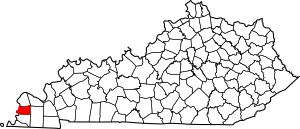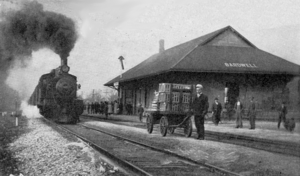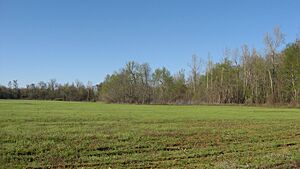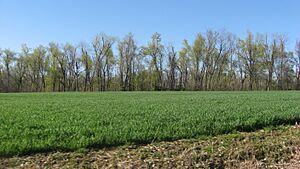National Register of Historic Places listings in Carlisle County, Kentucky facts for kids
Have you ever wondered about old buildings or places that are super important to history? In the United States, there's a special list called the National Register of Historic Places. It's like a hall of fame for places that tell us about the past. When a building, a site, or even a whole neighborhood gets on this list, it means it's recognized as a significant part of American history, architecture, archaeology, engineering, or culture.
Being on the National Register helps protect these places and makes people more aware of their importance. It's a way to make sure these special spots are remembered and cared for, so future generations can learn from them too.
In Carlisle County, Kentucky, there are five amazing places that have made it onto this important list. Let's explore them and discover the stories they hold!
Contents
What is the National Register of Historic Places?
The National Register of Historic Places is the official list of the nation's historic places worthy of preservation. It's managed by the National Park Service, which is part of the U.S. government. Think of it as a way to celebrate and protect the places that have shaped our country.
Why are places listed?
Places are added to the National Register for many reasons. Maybe they were home to famous people, or they saw important events happen. Some are great examples of old architecture, while others might be archaeological sites that teach us about ancient cultures. The main goal is to identify and honor places that have a special connection to history.
Historic Places in Carlisle County
Carlisle County has a few unique spots on the National Register. Each one tells a different story about the area's past.
Bardwell Illinois Central Railroad Station and Freight Depot
This historic railroad station was once a very busy place in Bardwell. It was added to the National Register on July 19, 1976. Train stations like this were super important in the past. They were hubs for travel and for moving goods, helping towns grow and connect with the rest of the country. Sadly, this station is no longer standing today, but its memory lives on through its place on the historic register. It reminds us of a time when trains were the main way to get around and transport things.
Marshall Site (15CE27)
The Marshall Site is an archaeological site located on a bluff overlooking the Mississippi River, northwest of Bardwell. It was added to the National Register on November 14, 1985. Archaeological sites are like giant puzzles that help us understand how people lived long, long ago. This site likely contains clues about ancient cultures that once lived along the Mississippi River. Archaeologists study these sites carefully to uncover tools, pottery, and other artifacts that tell us about the daily lives, customs, and history of early inhabitants.
Neville-Patterson-Lamkin House
This historic house is located on Kentucky Route 80 in Arlington. It was listed on the National Register on June 16, 1976. Old houses often have fascinating stories to tell about the families who lived there and the changes they witnessed over the years. The Neville-Patterson-Lamkin House is a great example of the kind of homes built in the area a long time ago. It helps us imagine what life was like for people in Carlisle County in the past.
George W. Stone House
Another historic home, the George W. Stone House, is also located on Kentucky Route 80, but this one is in Milburn. It joined the National Register on March 17, 1994. Like the Neville-Patterson-Lamkin House, this building offers a glimpse into the architectural styles and daily life of earlier times in Carlisle County. Preserving homes like these helps us connect with the people and history of the region.
Turk Site (15CE6)
Similar to the Marshall Site, the Turk Site is another important archaeological location. It's also found on a bluff near the Mississippi River, northwest of Bardwell, and was added to the National Register on November 14, 1985. Both the Marshall and Turk Sites are crucial for understanding the ancient history of the region. They provide valuable information about the early people who lived along the river, their cultures, and how they interacted with their environment. These sites are like open-air museums, full of hidden treasures that teach us about our distant past.





